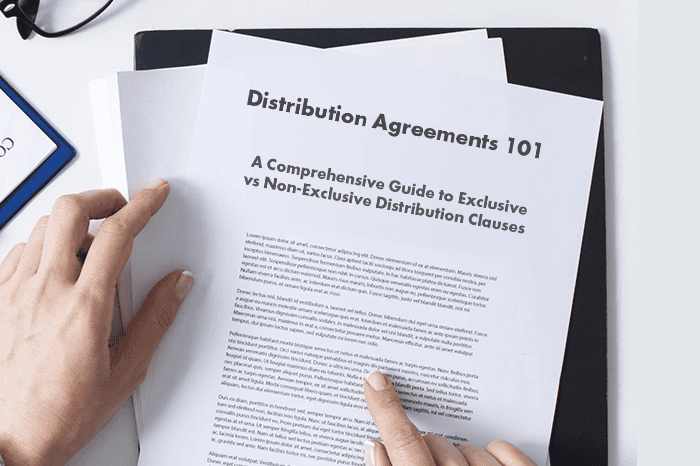
The supplier’s choice between exclusive and non-exclusive distribution provisions within a distribution agreement is essential as it impacts the relationship between the distributor and the supplier significantly.
An exclusive distribution clause prevents the supplier from forming other distribution contracts in a given market or territory. This gives the distributor the exclusive right to sell the products in that region. Exclusivity might be provided contingent on the distributor’s performance. The distributor might need to fulfill the required sales goals and adhere to other performance standards set by the supplier. In exchange for the exclusivity, the distributor might receive more assistance and resources from the supplier. This may entail specialized pricing, marketing, and promotional support.
A non-exclusive distribution clause, on the other hand, allows the supplier to sign numerous distribution contracts in the same market. This means that a supplier holds the right to trade with multiple distributors. This leads to the increase in the market potential for the supply alongside the diversification of their income sources. However, this may also have advantages for the distributor, depending on their scale and ambitions. The distributor may hold more freedom in the product’s price and marketing strategies as they are not compelled to reach a specified sales goal.
Pros and Cons of Exclusive Distribution Clause
Exclusive distribution clauses in a distribution contract can be beneficial to a diverse range of companies. This is especially true for businesses that hold a monopolistic position in a particular market or region for a specific product. Through this clause, businesses can exert a higher degree of control over the marketing and sales of their products as a single distributor holds the sole right to sell them. Additionally, they may acquire higher profits due to specialization, better alignment, and more resource allocation. Therefore exclusive distribution clauses can provide companies with a more attentive and efficient distribution strategy while assisting in building brand development and market success.
While there are many advantages to using an exclusive distribution clause in a distribution agreement, businesses should be aware of its drawbacks and disadvantages. For instance, exclusive distribution may decrease market potential and make it more difficult for companies to expand into new arenas. This is because a single distributor has limited resources to allocate for a single product. It could also be more expensive and require a larger marketing and advertising budget. There is always a chance that a distributor does not reach their performance goals or that market fluctuations render the supplier with few alternatives. Therefore, it is crucial to weigh the advantages and disadvantages of a distribution agreement before handing exclusivity to a distributor.
Pros and Cons of Non-Exclusive Distribution Clause
Comparing exclusive and non-exclusive distribution agreements, it is often observed that non-exclusive provisions cater to the requirements of a large array of business objectives. A non-exclusive distribution agreement permits a supplier to collaborate with various distributors in the same market or territory. This provides more distribution flexibility to the supplier and broadens the market for the product. Having multiple distributors for your product means that your business can secure a diverse consumer basis through these distributors. This arrangement requires fewer resources for marketing and advertising. Additionally, the risk of non-performance of a single distributor does not threaten the supplying company’s business success. Non-exclusive distribution agreements make business and trade structures more adaptable and agile in their distribution strategies. This provision also incentivizes healthy competition among distributors.
Despite the numerous benefits and options laid by a non-exclusive distribution clause, they carry their own drawbacks. Firstly, having several distributors means that the supplier has little control over the marketing and sales of their goods. This makes brand development within a territory extremely difficult. Secondly, multiple distributor coils mean additional resource allocation to track, monitor and regulate the performance, standard maintenance, and coordination amongst suppliers. This might render the non-exclusivity provision counterintuitive. Finally, the non-exclusive distribution could result in unhealthy rivalry among distributors. This could commercialize the product revenue and limit control over their products. In this approach, non-exclusive distribution clauses may increase flexibility and market reach, but coordinating between multiple distributors means the allocation of resources toward regulating multiple distributors.
What is more suitable for your company?
The choice of whether to incorporate an exclusive or non-exclusive distribution clause in a distribution agreement is dependent on numerous elements of your business and its requirements. An exclusive distribution clause can be your best option if your business requires more control over the marketing and sales of your product. If your company is aiming to build a strong brand presence in a particular market or territory, you should opt for an exclusive distribution agreement. This will provide your distributor security against the possibility of competition from other distributors and retain a consistent and strategize performance for the business.
A non-exclusive distribution agreement can be the best option for your business if it values and require adaptability and a wider market. If your product is not brand-oriented, you can appoint several distributors. As multiple distributors are authorized to sell your goods under this form of arrangement, it will swiftly help you reach a wider market and an efficient chance at expanding your products. Ultimately, the choice to employ exclusivity or non-exclusivity should be made after putting considerable thought into the requirements of your business’ products and the objectives your company has established for the upcoming years. You should carefully weigh the advantages and disadvantages of each distribution agreement before making the final decision.
Conclusion
The choice of whether to incorporate an exclusive or non-exclusive distribution clause in a distribution agreement relies on a number of variables. A company should consider its competitive position, objectives, and the extent of control they require. Exclusive distribution agreements may give you more control over marketing and sales, but limit your options and bear the higher expense. On the other hand, non-exclusive distribution clauses provide you with more adaptability and aid your company to expand its market. However, it may require more coordination and come with hazards of unhealthy competition among distributors. Finally, a company should consider these elements and carefully weigh its pros and cons to identify a strategy that can in provide it with the most extensive benefit after creating a distribution agreement.





